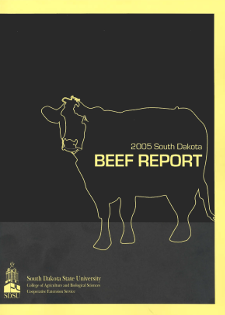Document Type
Report
Report Number
2005-18
Publication Date
2005
Keywords
feeding schedule, winter, steer calves, tympanic temperature
Summary
Angus steer calves (n=135) were used in a 55d feedlot growing study to investigate the effects of feeding schedule on tympanic temperature response when limit feeding. Steers were fed a high moisture ear corn diet (58 Mcal/cwt NEg) at 0900h (AM), 1500h (PM) or 50% at 0900h and 50% at 1500h (SPLIT) to allow for 2.50lb ADG. Climatic data were collected at 30 min intervals throughout the study via an on site automated weather station. Tympanic temperatures (TT) were collected every 30 min (5 steers/trt) for 5d (d44 to d48). Mean ambient temperature during the 5d TT collection period was -6.50F (-23.1 to 9.10F). After 55d, BW (802, 808 and 802lb), ADG (2.56, 2.67 and 2.52lb) and feed efficiency (5.73, 5.52 and 5.87) did not differ (P>.10) between AM, PM and SPLIT respectively, but followed rankings of previous research. Diurnal TT patterns were assessed by separating the day into three periods based on mean hourly wind chills (44.2, 17.8 and 7.50F) for Period 1 (0800 to 1600h), Period 2 (1630 to 2100h) and Period 3 (2130 to 0730h) respectively. Peak TT occurred during Period 2 for AM (102.40F) and Period 3 for PM (103.20F). SPLIT fed steers exhibited TT peaks of 103.90F or greater in each period. These data indicate that by adjusting feeding schedule it is possible to alter the time at which peak TT may occur, so that peak TT coincides with colder periods of the day. Elevated TT across all periods for SPLIT suggests that these steers may have increased metabolic rate to maintain normal TT during extreme cold. Additional research is needed to explain the changes in TT and how feeding times may impact energy partitioning.
Number of Pages
6
Format
application/pdf
Language
en
Publisher
South Dakota State University
Rights
Copyright © 2005 South Dakota State University
Recommended Citation
Holt, Simone M. and Pritchard, Robbi H., "Effect of Feeding Schedule on Tympanic Temperature of Steer Calves During Winter" (2005). South Dakota Beef Report, 2005. 19.
https://openprairie.sdstate.edu/sd_beefreport_2005/19


